+ Open data
Open data
- Basic information
Basic information
| Entry |  | |||||||||
|---|---|---|---|---|---|---|---|---|---|---|
| Title | The AAVpo.6 capsid | |||||||||
 Map data Map data | ||||||||||
 Sample Sample |
| |||||||||
 Keywords Keywords | AAVpo.6 / porcine adeno-associated virus / gene therapy / vector / cryo-EM / VIRUS | |||||||||
| Function / homology | Phospholipase A2-like domain / Phospholipase A2-like domain / Parvovirus coat protein VP2 / Parvovirus coat protein VP1/VP2 / Parvovirus coat protein VP2 / Capsid/spike protein, ssDNA virus / T=1 icosahedral viral capsid / structural molecule activity / Capsid protein VP1 Function and homology information Function and homology information | |||||||||
| Biological species |  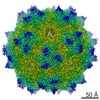 Adeno-associated virus Adeno-associated virus | |||||||||
| Method | single particle reconstruction / cryo EM / Resolution: 1.77 Å | |||||||||
 Authors Authors | Nelson A / Mietzsch M / McKenna R | |||||||||
| Funding support |  United States, 1 items United States, 1 items
| |||||||||
 Citation Citation |  Journal: Viruses / Year: 2025 Journal: Viruses / Year: 2025Title: Structural and Functional Characterization of Porcine Adeno-Associated Viruses. Authors: Austin Nelson / Mario Mietzsch / Jane Hsi / Julia Eby / Paul Chipman / Robert McKenna /  Abstract: Current gene therapy treatments utilizing adeno-associated virus (AAV) vectors are based on capsids of primate origin. However, pre-existing neutralizing anti-AAV antibodies, that are present in a ...Current gene therapy treatments utilizing adeno-associated virus (AAV) vectors are based on capsids of primate origin. However, pre-existing neutralizing anti-AAV antibodies, that are present in a significant portion of the population, can lead to vector inactivation and reduced therapeutic efficacy. Advances in DNA sequencing have facilitated the discovery of many AAVs from non-primate species, including isolates from pigs, which exhibit up to 50% capsid protein sequence divergence, compared to primate AAV serotypes. In this study, AAVs isolated from porcine tissues (AAVpo.1 and AAVpo.6) were selected for structural characterization due to their low capsid protein VP1 sequence identity compared to each other and to AAV9. The AAV vectors were produced via the standard triple transfection system in HEK293 cells using AAV2 to package AAV2-ITR vector genomes and were purified by iodixanol density gradient ultracentrifugation. The capsid structures of AAVpo.1 and AAVpo.6 were determined using cryo-electron microscopy and then compared to each other in addition to the AAV5 and AAV9 structures. Given that porcine AAVpo.6 has been reported to infect human cells and the ability to cross the blood-brain barrier, the functional characterization was focused on the identification of a potential glycan receptor utilized by the porcine capsids. Additionally, the porcine AAV capsid reactivity to human derived anti-AAV antibodies was assessed to evaluate the potential for these capsids to be used as alternative vectors for gene therapy, particularly for patients with pre-existing immunity to primate-derived AAV serotypes. | |||||||||
| History |
|
- Structure visualization
Structure visualization
| Supplemental images |
|---|
- Downloads & links
Downloads & links
-EMDB archive
| Map data |  emd_49739.map.gz emd_49739.map.gz | 262.6 MB |  EMDB map data format EMDB map data format | |
|---|---|---|---|---|
| Header (meta data) |  emd-49739-v30.xml emd-49739-v30.xml emd-49739.xml emd-49739.xml | 14.2 KB 14.2 KB | Display Display |  EMDB header EMDB header |
| Images |  emd_49739.png emd_49739.png | 68.2 KB | ||
| Filedesc metadata |  emd-49739.cif.gz emd-49739.cif.gz | 5.5 KB | ||
| Others |  emd_49739_half_map_1.map.gz emd_49739_half_map_1.map.gz emd_49739_half_map_2.map.gz emd_49739_half_map_2.map.gz | 162.6 MB 162.6 MB | ||
| Archive directory |  http://ftp.pdbj.org/pub/emdb/structures/EMD-49739 http://ftp.pdbj.org/pub/emdb/structures/EMD-49739 ftp://ftp.pdbj.org/pub/emdb/structures/EMD-49739 ftp://ftp.pdbj.org/pub/emdb/structures/EMD-49739 | HTTPS FTP |
-Validation report
| Summary document |  emd_49739_validation.pdf.gz emd_49739_validation.pdf.gz | 1.1 MB | Display |  EMDB validaton report EMDB validaton report |
|---|---|---|---|---|
| Full document |  emd_49739_full_validation.pdf.gz emd_49739_full_validation.pdf.gz | 1.1 MB | Display | |
| Data in XML |  emd_49739_validation.xml.gz emd_49739_validation.xml.gz | 16.8 KB | Display | |
| Data in CIF |  emd_49739_validation.cif.gz emd_49739_validation.cif.gz | 19.9 KB | Display | |
| Arichive directory |  https://ftp.pdbj.org/pub/emdb/validation_reports/EMD-49739 https://ftp.pdbj.org/pub/emdb/validation_reports/EMD-49739 ftp://ftp.pdbj.org/pub/emdb/validation_reports/EMD-49739 ftp://ftp.pdbj.org/pub/emdb/validation_reports/EMD-49739 | HTTPS FTP |
-Related structure data
| Related structure data |  9nrpMC 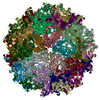 9n5xC M: atomic model generated by this map C: citing same article ( |
|---|---|
| Similar structure data | Similarity search - Function & homology  F&H Search F&H Search |
- Links
Links
| EMDB pages |  EMDB (EBI/PDBe) / EMDB (EBI/PDBe) /  EMDataResource EMDataResource |
|---|---|
| Related items in Molecule of the Month |
- Map
Map
| File |  Download / File: emd_49739.map.gz / Format: CCP4 / Size: 282.6 MB / Type: IMAGE STORED AS FLOATING POINT NUMBER (4 BYTES) Download / File: emd_49739.map.gz / Format: CCP4 / Size: 282.6 MB / Type: IMAGE STORED AS FLOATING POINT NUMBER (4 BYTES) | ||||||||||||||||||||||||||||||||||||
|---|---|---|---|---|---|---|---|---|---|---|---|---|---|---|---|---|---|---|---|---|---|---|---|---|---|---|---|---|---|---|---|---|---|---|---|---|---|
| Projections & slices | Image control
Images are generated by Spider. | ||||||||||||||||||||||||||||||||||||
| Voxel size | X=Y=Z: 0.83 Å | ||||||||||||||||||||||||||||||||||||
| Density |
| ||||||||||||||||||||||||||||||||||||
| Symmetry | Space group: 1 | ||||||||||||||||||||||||||||||||||||
| Details | EMDB XML:
|
-Supplemental data
-Half map: #1
| File | emd_49739_half_map_1.map | ||||||||||||
|---|---|---|---|---|---|---|---|---|---|---|---|---|---|
| Projections & Slices |
| ||||||||||||
| Density Histograms |
-Half map: #2
| File | emd_49739_half_map_2.map | ||||||||||||
|---|---|---|---|---|---|---|---|---|---|---|---|---|---|
| Projections & Slices |
| ||||||||||||
| Density Histograms |
- Sample components
Sample components
-Entire : Adeno-associated virus
| Entire | Name:   Adeno-associated virus Adeno-associated virus |
|---|---|
| Components |
|
-Supramolecule #1: Adeno-associated virus
| Supramolecule | Name: Adeno-associated virus / type: virus / ID: 1 / Parent: 0 / Macromolecule list: all / NCBI-ID: 272636 / Sci species name: Adeno-associated virus / Sci species strain: AAVpo.6 / Virus type: VIRION / Virus isolate: STRAIN / Virus enveloped: No / Virus empty: No |
|---|
-Macromolecule #1: Capsid protein VP1
| Macromolecule | Name: Capsid protein VP1 / type: protein_or_peptide / ID: 1 / Number of copies: 60 / Enantiomer: LEVO |
|---|---|
| Source (natural) | Organism:   Adeno-associated virus / Strain: AAVpo.6 Adeno-associated virus / Strain: AAVpo.6 |
| Molecular weight | Theoretical: 59.349449 KDa |
| Recombinant expression | Organism:  Homo sapiens (human) Homo sapiens (human) |
| Sequence | String: MASGSGAPMA DNNEGADGVG NASGNWHCDS TWLGDRVITT STRTWALPTY NNHLYKQISS QSGANNDNHY FGYSTPWGYF DFNRFHCHF SPRDWQRLIN NNWGFRPKRL NFKLFNIQVK EVTQTDGTKT IANNLTSTVQ VFADSEYQLP YVLGSAHQGC F PPFPADVF ...String: MASGSGAPMA DNNEGADGVG NASGNWHCDS TWLGDRVITT STRTWALPTY NNHLYKQISS QSGANNDNHY FGYSTPWGYF DFNRFHCHF SPRDWQRLIN NNWGFRPKRL NFKLFNIQVK EVTQTDGTKT IANNLTSTVQ VFADSEYQLP YVLGSAHQGC F PPFPADVF MVPQYGYLTL NNGSQAMGRS SFYCLEYFPS QMLRTGNNFT FSYTFEDVPF HSSYAHSQSL DRLMNPLIDQ YL YYLSKTQ NGLGFSQAGH NSMRDQSRNW LPGPCFRQQR ISKTPTQNNT GDFAWTGTTR YHLNGRNSAM NPGPAMASHK DDE ERFFPQ NGVLIFGKED AEKNNAVLDK VIITDEEEIR TTNPVATGEY GLVATNFQNN TTAADTEMVN AQGILPGMVW QDRD VYLQG PIWAKIPHTD GHFHPSPLMG GFGLKRPPPQ ILIKNTPVPA DPATTFNPAK LASFITQYST GQVSVEIEWE LQKEN SKRW NPEVQYTSNY NKSVNVEFTV DNNGVYSEPR TIGTRYLTRN L UniProtKB: Capsid protein VP1 |
-Experimental details
-Structure determination
| Method | cryo EM |
|---|---|
 Processing Processing | single particle reconstruction |
| Aggregation state | particle |
- Sample preparation
Sample preparation
| Buffer | pH: 7.4 |
|---|---|
| Vitrification | Cryogen name: ETHANE |
- Electron microscopy
Electron microscopy
| Microscope | TFS KRIOS |
|---|---|
| Image recording | Film or detector model: FEI FALCON IV (4k x 4k) / Average electron dose: 50.0 e/Å2 |
| Electron beam | Acceleration voltage: 300 kV / Electron source:  FIELD EMISSION GUN FIELD EMISSION GUN |
| Electron optics | Illumination mode: FLOOD BEAM / Imaging mode: BRIGHT FIELD / Nominal defocus max: 2.2 µm / Nominal defocus min: 0.8 µm |
| Experimental equipment |  Model: Titan Krios / Image courtesy: FEI Company |
 Movie
Movie Controller
Controller




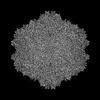

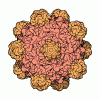
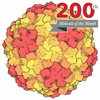
 Z (Sec.)
Z (Sec.) X (Row.)
X (Row.) Y (Col.)
Y (Col.)




































